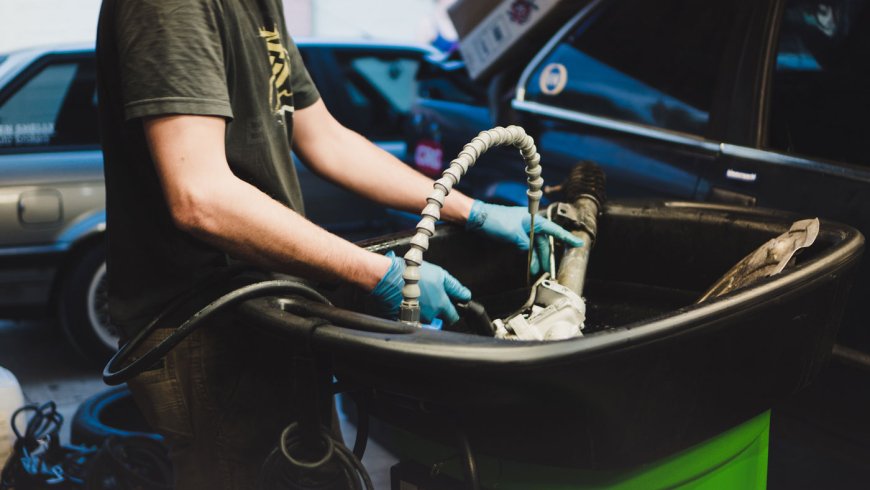Washing Auto Parts Nature’s Way
CRC smartwasher washes autoparts safely – and it cleans up workshop’s environmental impact Washing auto parts in a kerosene or solvent bath is wrong in so many ways. It exposes people to skin irritants and vapours. It creates toxic liquid

CRC smartwasher washes autoparts safely – and it cleans up workshop’s environmental impact
Washing auto parts in a kerosene or solvent bath is wrong in so many ways. It exposes people to skin irritants and vapours. It creates toxic liquid waste, and you end up trying to clean parts with a filthy liquid.
The CRC SmartWasher changes all that. It uses a pH natural, Non-hazardous, Non-flammable water-based cleaning solution charged with 15 types of microbes that literally eat greases and oils, converting them to CO2 & Water. That leaves just about 3.3Kg of inert solid waste to dispose of a year compared with 377 Kg of hazardous waste – plus disposal fee – for solvents changed every six weeks. And washing parts at a comfortable 42 degrees in a SmartWasher can even be a pleasant job on a cold morning.
There’s nothing like the SmartWasher in the market and the microbe powered SmartWasher massively outsells simpler water-based units that still require liquid waste disposal and have a less effective cold wash. There’s no need to change the liquid in a SmartWasher. Just change the filter mat once a month and top-up the “OzzyJuice” Cleaner, as required. The filter traps larger particles and emulsified waste drops into the tank where microbes consume it at the rate of one or two litres per week.
Customers were mostly driven to SmartWashers because of a bad reaction of parts washer solvents on their skin. Now that owners and bosses also carry liability for workers who don’t use PPE with hazardous parts washer solvents, proactive safety is even more of a motivation – for staff & for the environment.
SmartWashers are a big hit with dealers wanting modern equipment that improves safety & efficiency.
Managers faced with an annual waste reduction target can often hit it with just this one move.
The benefits are just as great for smaller workshops, which have the same WorkSafe liabilities. People want to use safer and more environmentally responsible parts washers today, and we even put branding on some workshops who wish to show their customers they are dealing with waste and their worker’s health responsibly.
But is a ‘bioremediating parts washer’ as effective as a solvent bath? They are just as effective, sometimes better. The OzzyJuice detergent type cleaner has been reformulated and improved several times over the years, and that has ramped up again since CRC bought SmartWasher five years ago and applied its much greater R&D resources to the product.
“Solvents attack deposits from the outside where as a surfactant like “OzzyJuice” breaks the bond between the part and the dirt, so it lifts off rather than dissolves it off.” That means cleaning action looks different, but it can dislodge deposits the same as solvents and even some that solvents won’t wash.
Better in Every Way
WORKSHOPS LOOKING TO RAISE THEIR ENVIRONMENTAL PERFORMANCE – AND IMPROVE STAFF SAFETY – HAVE AN OBVIOUS MOVE
Spraying solvents or using solvent – soaked rags to remove grease and grime or washing parts in a solvent bath is a dirty job. It’s such a basic task, the idea it could be done away with entirely is quite revolutionary.
Introduction of the SmartWasher is literally that revolutionary.
The SmartWasher system replaces the traditional solvent bath. It feels different to use because instead of dissolving grease with a dangerous chemical, it uses special safe detergent called “OzzyJuice” that is heated to dislodge dirt and grease. It’s much safer to use. But it’s the next part that’s revolutionary. The OzzyJuice degreaser flows down through a filter into a tank containing microbes that literally eat the oil and grease. The tank has a heater to keep the degreaser at around 40 degrees because that is the temperature the microbes are most active. An electric pump moves the cleaning solution from a storage tank to a basin where parts are cleaned. The basin collects the cleaning solution, and it flows back into the storage tank. The SmartWasher uses a pH neutral, non-hazardous, non-flammable water-based cleaning solution charged with 15 types of microbes that literally eat grease and oils, converting them to CO2 and water. This is the same technology used in waste water treatment plants. Microbes have been successfully used in petroleum and chemical plants, refineries, food processing plants, marine barges, truck washes, wood treating plants and groundwater remediation. This bioremediation process is also used to help clean up oil spills such as the Deepwater Horizon disaster. Maintenance can be as simple as replacing a filter mat once a month. The OzzyMat traps particulates as small as 50 microns to keep the tank free of debris. The new Ozzy Mats also add new microbes.
Hits: 118








